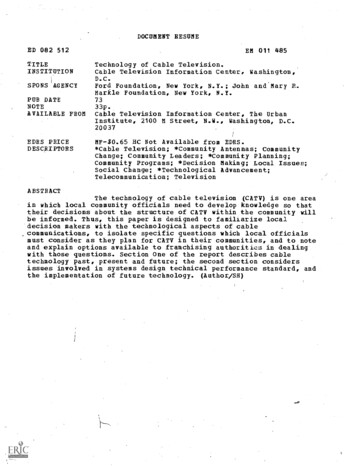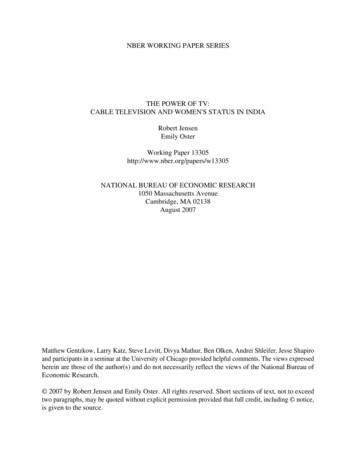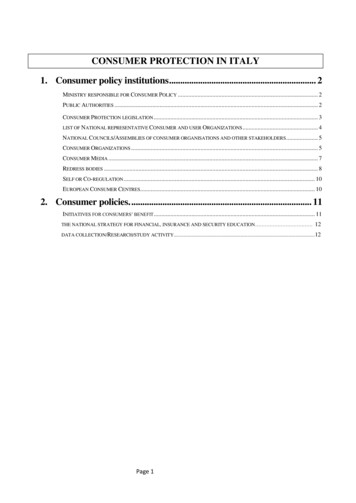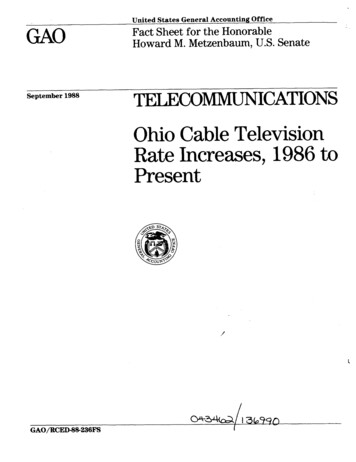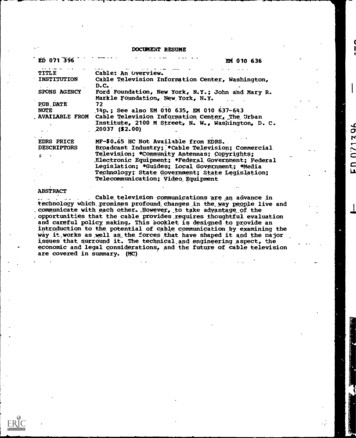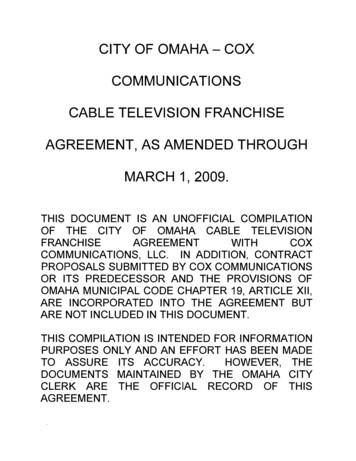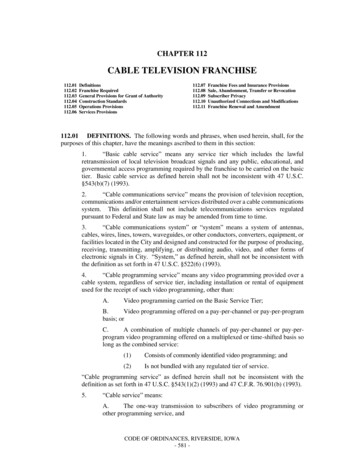
Transcription
PUBLIC LAW 102-385--OCr. 5, 1992CABLE TELEVISION CONSUMERPROTECTION AND COMPETITION ACT OF1992,4-19o - W (*451
106 STAT. 1460PUBLIC LAW 102-385-- CT. 5, 1992Public Law 102-385102d CongressAn Act .0ct. 5,1992rI 121Cable TelevisionConsumerProtection andCompetition Actof 199a2Business andindustry.47 USC 609 note.47 USC 521 note.To amend the Communic.tiona Ad of 1934 to provide increased consumer protectionand to promote increased competition in the cable television and related mareta,and for other purposes.Be it enacted by the Senate and House of Representatives ofthe United States of America in Congressassembled,SECTION 1. SHORT TTVLEThis Act may be cited as the 'Cable Television ConsumerProtection and Competition Act of 1992?.SEC. 2. FINDINGS; POLICY; DEFINITIONS.(a) FINDNOs.-The Congress finds and declares the following.(1) Pursuant to the Cable Communications Policy Act of1984, rates for cable television services have been deregulatedin approximately 97 percent of all franchises since December29, 1986. Since rate deregulation, monthly rates for the lowestpriced basic cable service have increased by 40 percent ormore for 28 percent of cable television subscribers. Althoughthe average number of basic channels has increased from about24 to 30 average monthly rates have increased by 29 percentduring the same period. The average monthly cable rate hasincreased almost 3 times as much as the Consumer Price Indexsince rate deregulation.(2) For a variety of reasons, including local franchisingrequirements and the extraordinary expense of constructingmore than one cable television system to serve a particulargeographic area, most cable television subscribers have noopportunity to select between competing cable systems. Withoutthe presence of another multichannel video programming distributor, a cable system faces no local competition. The resultis undue market power for the cable operator as comparedto that of consumers and video programmers.(3) There has been a substantial increase in the penetrationof cable television systems over the past decade. Nearly56,000,000 households, over 60 percent of the households withtelevisions, subscribe to cable television and this percentageis almost certain to increase. As a result of this growth, thecable television industry has become a dominant nationwidevideo medium.(4) The cable industry has become highly concentrated.The potential effects of such concentration are barriers to entryfor new programmers and a reduction in the number of mediavoices available to consumers.(5) The cable industry has become vertically integrated;cable operators and cable programmers often have commonownership. As a result, cable operators have the incentive andability to favor their affiliated programmers. This could makeit more difficult for noncable-affiliated programmers to secure
PUBLIC LAW 102-385--OCT. 5, 1992106 STAT. 1461carriage on cable systems. Vertically integrated program suppliers also have the incentive and ability to favor their affiliatedcable operators over nonaffiliated cable operators and programming distributors using other technologies.(6) There is a substantial governmental and First Amendment interest in promoting a diversity of views providedthrough multiple technology media.(7) There is a substantial governmental and First Amendment interest in ensuring that cable subscribers have accessto local noncommercial educational stations which Congresshas authorized, as expressed in section 396(aX5) of the Communications Act of 1934. The distribution of unique noncommercial, educational programming services advances thatinterest.(8) The Federal Government has a substantial interestin making all nonduplicative local public television servicesavailable on cable systems because(A-) public television provides educational and informational programming to the Nation's citizens, therebyadvancing the Government's compelling interest in educating its citizens;(B) public television is a local community institution,supported through local tax dollars and voluntary citizencontributions in excess of 10,800,000,000 since 1972, thatprovides public service programming that is responsiveto the needs and interests of the local community;-,(C) the Federal Government, in recognition of publictelevision's integral role in serving the educational andinformational needs of local communities, has investedmore than 3,000,000,000 in public broadcasting since1969; and(D) absent carriage requirements there is a substantiallikelihood that citizens, who have supported local publictelevision services, will be deprived of those services.(9) The Federal Government has a substantial interestin having cable systems carry the signals of local commercialtelevision stations because the carriage of such signals is necessary to serve the goals contained in section 307(b) of theCommunications Act of 1934 of providing a fair, efficient, andequitable distribution of broadcast services.(10) A primary objective and benefit of our Nation's systemof regulation of television broadcasting is the local originationof programming. There is a substantial governmental interestin ensuring its continuation.(11) Broadcast television stations continue to be an important source of local news and public affairs programming andother local broadcast services critical to an informed electorate.(12) Broadcast television programming is supported by revenues generated from advertising broadcast over stations. Suchprogramming is otherwise free to those who own televisionsets and do not require cable transmission to receive broadcastsignals. There is a substantial governmental interest in promoting the continued availability of such free television programming, especially for viewers who are unable to afford othermeans of receiving programming.
106 STAT. 1462PUBLIC LAW 102-385--OCT. 5, 1992(13) As a result of the growth of cable television, therehas been a marked shift in market share from broadcast television to cable television services.(14) Cable television systems and broadcast television stations increasingly compete for television advertising revenues.As the proportion of households subscribing to cable televisionincreases, proportionately more advertising revenues will bereallocated from broadcast to cable television systems.(15) A cable television system which carries the signalof a local television broadcaster is assisting the broadcasterto increase its viewership, and thereby attract additionaladvertising revenues that otherwise might be earned by thecable system operator. As a result, there is an economic incentive for cable systems to terminate the retransmission of thebroadcast signal, refuse to carry new signals, or repositiona broadcast signal to a disadvantageous channel position. Thereis a substantial likelihood that absent the reimposition of sucha requirement, additional local broadcast signals will be deleted,repositioned, or not carried.(16) As a result of the economic incentive that cable systemshave to delete, reposition, or not carry local broadcast signals,coupled with the absence of a requirement that such systemscarry local broadcast signals, the economic viability of freelocal broadcast television and its ability to originate qualitylocal programming will be seriously jeopardized.(17) Consumers who subscribe to cable television oftendo so to obtain local broadcast signals which they otherwisewould not be able to receive, or to obtain improved signals.Most subscribers to cable television systems do not or cannotmaintain antennas to receive broadcast television services, donot have input selector switches to convert from a cable toantenna reception system, or cannot otherwise receive broadcast television services. The regulatory system created by theCable Communications Policy Act of 1984 was premised uponthe continued existence of mandatory carriage obligations forcable systems, ensuring that local stations would be protectedfrom anticompetitive conduct by cable systems.(18) Cable television systems often are the single mostefficient distribution system for television programming. A Government mandate for a substantial societal investment in alternative distribution systems for cable subscribers, such as the'A/B" input selector antenna system, is not an enduring orfeasible method of distribution and is not in the public interest.(19) At the same time, broadcast programming that iscarried remains the most popular programming on cable systems, and a substantial portion of the benefits for which consumers pay cable systems is derived from carriage of the signalsof network affiliates, independent television stations, and publictelevision stations. Also cable programming placed on channelsadjacent to popular off-the-air signals obtains a larger audiencethan on other channel positions. Cable systems, thereforeobtain great benefits from local broadcast signals which, untilnow, they have been able to obtain without the consent ofthe broadcaster or any copyright liability. This has resultedin an effective subsidy of the development of cable systemsby local broadcasters. While at one time, when cable systemsdid not attempt to compete with local broadcasters for program-
PUBLIC LAW 102-385-OCT. 5, 1992106 STAT. 1463ming, audience, and advertising, this subsidy may have beenappropriate, it is so no longer and results in a competitiveimbalance between the 2 industries.(20) The Cable Communications Policy Act of 1984, inits amendments to the Communications Act of 1934, limitedthe regulatory authority of franchising authorities over cableoperators. Franchising authorities are finding it difficult underthe current regulatory scheme to deny renewals to cable systems that are not adequately serving cable subscribers.(21) Cable systems should be encouraged to carry lowpower television stations licensed to the communities servedby those systems where the low-power station creates andbroadcasts, as a substantial part of its programming day, localprogramming.(b) STATEMENT OF Poucy.-It is the policy of the Congressin this Act to(1) promote the availability to the public of a diversityof views and information through cable television and othervideo distribution media;(2) rely on the marketplace, to the maximum extent feasible, to achieve that availability;,(3) ensure that cable operators continue to expand, whereeconomically justified, their capacity and the programs offeredover their cable systems;(4) where cable television systems are not subject to effective competition, ensure that consumer interests are protectedin receipt of cable service; and(5) ensure that cable television operators do not have unduemarket power vis-a-vis video programmers and consumers.(C) DEFiNITTONs.-Sectjon 602 of the Communications Act of47 USC 5221934 (47 U.S.C. 531) is amended(1) by redesignating paragraph (16) as paragraph (19);(2) by striking "and' at the end of paragraph (15);(3) by redesignating paragraphs (11) through (15) as paragraphs (13) through (17), respectively;(4) by .redesignating paragraphs (1) through (10) as paragraphs (2) through (11), respectively;(5) by inserting before paragraph (2) (as so redesignated)the following new paragraph:'(1) the term 'activated channels' means those channelsengineered at the headend of a cable system for the provisionof services generally available to residential subscribers of thecable system, regardless of whether such services actually areprovided, including any channel designated for public, educational, or governmental use;";(6) by inserting after paragraph (11) (as so redesignated)the following new paragraph:"(12) the term 'multichannel video programming distributor' means a person such as, but not limited to, a cable operator,a multichannel multipoint distribution service, a direct broadcast satellite service, or a television receive-only satellite program distributor, who makes available for purchase, by subscribers or customers, multiple channels of video programming,"; and(7) by inserting after paragraph (17) (as so redesignated)the following new paragraph:
106 STAT. 1464PUBLIC LAW 102-385--Or. 5, 1992"(18) the term 'usable activated channels' means activatedchannels of a cable system, except those channels whose usefor the distribution of broadcast signals would conflict withtechnical and safety regulations as determined by the Commission; and".SEC. 3. REGULATION OF RATES.(a) AMENDMENT.-Section 623 of the Communications Act of1934 (47 U.S.C. 543) is amended to read as follows:bSEC. 623. REGULATION OF RATES.'(a) COMPETrMON PREFERENCE; LOCAL AND FEDERAL RECGUATION.'(1) IN GENERAL--No Federal agency or State may regulatethe rates for the provision of cable service except to the extentprovided under this section and section 612. Any franchisingauthority may regulate the rates for the provision of cableservice, or any other communications service provided overa cable system to cable subscribers, but only to the extentprovided under this section. No Federal agency, State, or franchising authority may regulate the rates for cable service ofa cable system that is owned or operated by a local governmentor franchising authority within whose jurisdiction that cablesystem is located and that is the only cable system locatedwithin such jurisdiction."(2) PREFERENCE FOR COMPETITION.-If the Commissionfinds that a cable system is subject to effective competition,the rates for the provision of cable service by such systemshall not be subject to regulation by the Commission or bya State or franchising authority under this section. If the Commission finds that a cable system is not subject to effectivecompetition"(A) the rates for the provision of basic cable serviceshall be subject to regulation by a franchising authority,or by the Commission if the Commission exercises jurisdiction pursuant to paragraph (6), in accordance with theregulations prescribed by the Commission under subsection(b); and"(B) the rates for cable programming services shallbe subject to regulation by the Commission under subsection (c)."(3) QUALIFICATION OF FRANCHISING AUTHORITY.-A franchising authority that seeks to exercise the regulatory jurisdiction permitted under paragraph (2XA) shall file with the Commission a written certification that"(A) the franchising authority will adopt and administer regulations with respect to the rates subject to regulation under this section that are consistent with the regulations prescribed by the Commission under subsection (b);"(3) the franchising authority has the legal authorityto adopt, and the personnel to administer, such regulations;and'(C) procedural laws and regulations applicable to rateregulation proceedings by such authority provide a reasonable opportunity for consideration of the views of interestedparties."(4) APPROVAL BY COMMISSION.-A certification filed by afranchising authority under paragraph (3) shall be effective
PUBLIC LAW 102-385--OCr. 5, 199210-6 STAT. 146530 days after the date on which it is filed unless the Commissionfinds, after notice to the authority and a reasonable opportunityfor the authority to comment, that'(A) the franchising authority has adopted or is administering regulations with respect to the rates subject toregulation under this section that are not consistent withthe regulations prescribed by the Commission under subsection (b);'(B) the franchising authority does not have the legalauthority to adopt, or the personnel to administer, suchregulations; or'(C) procedural laws and regulations applicable to rateregulation proceedings by such authority do not providea reasonable opportunity for consideration of the viewsof interested parties.If the Commission disapproves a franchising authority's certification, the Commission shall notify the franchising authorityof any revisions or modifications necessary to obtain approval."(5) REVOCATION OF JURSDICTION.--Upon petition by acable operator or other interested party, the Commission shallreview the regulation of cable system rates by a franchisingauthority under this subsection. A copy of the petition shallbe provided to the franchising authority by the person filingthe petition. If the Commission finds that the franchisingauthority has acted inconsistently with the requirements ofthis subsection, the Commission shall grant appropriate relief.If the Commission, after the franchising authority has hada reasonable opportunity to comment, determines that the Stateand local laws and regulations are not in conformance withthe regulations prescribed by the Commission under subsection(b), the Commission shall revoke the jurisdiction of such authority."(6) EXERCISE OF JURISDICTION BY COMMISSION.-If theCommission disapproves a franchising authority's certificationunder paragraph (4), or revokes such authority's jurisdictionunder paragraph 5), the Commission shall exercise the franchising authority's regulatory jurisdiction under paragraph(2XA) until the franchising authority has qualified to exercisethat jurisdiction by filing a new certification that meets therequirements of paragraph (3). Such new certification shallbe effective upon approval by the Commission. The Commissionshall act to approve or disapprove any such new certificationwithin 90 days after the date it is filed."(b) ESTABLISHMENT OF BASIC SERVICE TIER RATE REGULATIONS."(1) COMMISSION OBLIGATION TO SUBSCRIBERS.-The Commission shall, by regulation, ensure that the rates for thebasic service tier are reasonable. Such regulations shall bedesigned to achieve the goal of protecting subscribers of anycable system that is not subject to effective competition fromrates for the basic service tier that exceed the rates that wouldbe charged for the basic service tier if such cable system weresubject to effective competition.'(2) COMMISSION REGULATIONS.-Within 180 days after thedate of enactment of the Cable Television Consumer Protectionand Competition Act of 1992, the Commission shall prescribe,and periodically thereafter revise, regulations to carry out its
106 STAT. 1466PUBLIC LAW 102-385--OCT. 5, 1992obligations under paragraph (1). In prescribing such regulations, the Commission"(A) shall seek to reduce the administrative burdenson subscribers, cable operators, franchising authorities, andthe Commission;"(B) may adopt formulas or other mechanisms andprocedures in complying with the requirements of subparagraph (A), and'(C) shall take into account the following factors:'(i) the rates for cable systems, if any, that aresubject to effective competition;"(ii) the direct costs (if any) of obtaining, transmitting, and otherwise providing signals carried on thebasic service tier, including signals and services carriedon the basic service tier pursuant to paragraph (7)(B),and changes in such costs;'(iii) only such portion of the joint and commoncosts (if any) of obtaining, transmitting, and otherwiseproviding such signals as is determined, in accordancewith regulations prescribed by the Commission, to bereasonably and properly allocable to the basic servicetier, and changes in such costs;'(iv) the revenues (if any) received by a cableoperator from advertising from programming that iscarried as part of the basic service tier or from otherconsideration obtained in connection with the basicservice tier;"(v) the reasonably and properly allccable portionof any amount assessed as a franchise fee, tax, orcharge of any kind imposed by any State or localauthority on the transactions between cable operatorsand cable subscribers or any other fee, tax, or assessment of general applicability imposed by a governmental entity applied against cable operators or cablesubscribers;"(vi) any amount required, in accordance withparagraph (4), to satisfy franchise requirements to support piiblic, educational, or governmental channels orthe use of such channels or any other services requiredunder the franchise; and"(vii) a reasonable profit, as defined by the Commission consistent with the Commission's obligationsto subscribers under paragraph (1)."(3) EQUTPMENT.-The regulations prescribed by the Commission under this subsection shall include standards to establish, on the basis of actual cost, the price or rate for"(A) installation and lease of the equipment used bysubscribers to receive the basic service tier, including aconverter box and a remote control unit and, if requestedby the subscriber, such addressable converter box or otherequipment as is required to access programming describedin paragraph (8); and"(B) installation and monthly use of connections foradditional television receivers."(4) COSTS OF FRANCHISE REQUIREMENTS.--The regulationsprescribed by the Commission under this subsection shallinclude standards to identify costs attributable to satisfying
PUBLIC LAW 102-385--OCT. 5, 1992106 STAT. 1467franchise requirements to support public, educational and governmental channels or the use of such channels or any otherservices required under the franchise."(5) IMPLEMENTATION AND ENFORCEMENT.-The regulationsprescribed by the Commission under this subsection shallinclude additional standards, guidelines, and procedures concerning the implementation and enforcement of such regulations, which shall include"(A) procedures by which cable operators may implement and franchising authorities may enforce the regulations prescribed by the Commission under this subsection;"(B) procedures for the expeditious resolution of disputes between cable operators and franchising authoritiesconcerning the administration of such regulations;'(C) standards and procedures to prevent unreasonablecharges for changes in the subscriber's selection of servicesor equipment subject to regulation under this section, whichstandards shall require that charges for changing the service tier selected shall be based on the cost of such changeand shall not exceed nominal amounts when the system'sconfiguration permits changes in service tier selection tobe effected solely by coded entry on a computer terminalor by other similarly simple method; and"(D) standards and procedures to assure that subscribers receive notice of the availability of the basic servicetier required under this section."(6) NoTIcE.-The procedures prescribed by the Commission pursuant to paragraph (5XA) shall require a cable operatorto provide 30 days' advance notice to a franchising authorityof any increase proposed in the price to be charged for thebasic service tier."(7) COMPONENTS OF BASIC TIER SUBJECT TO RATE REGULATION.i(A) MINIMUN CONTENTS.-Each cable operator of acable system shall provide its subscribers a separatelyavailable basic service tier to which subscription is requiredfor access to any other tier of service. Such basic servicetier shall, at a minimum, consist of the following:"(i) All signals carried in fulfillment of the requirements of sections 614 and 615."(ii) Any public, educational, and governmentalaccess programming required by the franchise of thecable system to be provided to subscribers."(iii) Any signal of any television broadcast stationthat is provided by the cable operator to any subscriber,except a signal which is secondarily transmitted bya satellite carrier beyond the local service area of suchstation.i(B) PERMITTED ADDITIONS TO BASIC TIER--A cableoperator may add additional video programming signalsor services to the basic service tier. Any such additionalsignals or services provided on the basic service tier shallbe provided to subscribers at rates determined under theregulations prescribed by the Commission under this subsection."(8) BUY-THROUGH OF OTHER TIERS PROHIBITED.-
106 STAT. 1468PUBLIC LAW 102-385--OCT. 5, 1992(A) PRomHBroN.-A cable operator may not requirethe subscription to any tier other than the basic servicetier required by paragraph (7) as a condition of accessto video programing.offeredon a per channel or perprogram basis. A cable operator may not discriminatebetween subscribers to the basic service tier and othersubscribers with regard to the rates charged for video programming offered on a per channel or per program basis."(B) ExcEPrnON; LJU TATON.-The prohibition in subparagraph (A) shall not apply to a cable system that, byreason of the lack of addressable converter boxes or othertechnological limitations, does not permit the operator tooffer programming on a per channel or per program basisin the same manner required by subparagraph (A). Thissubparagraph shall not be available to any cable operatorafter(i) the technology utilized by the cable systemis modified or improved in a way that eliminates suchtechnological limitation; or'(ii) 10 years after the date of enactment of theCable Television Consumer Protection and CompetitionAct of 1992, subject to subparagraph (C).i(C) WAiER-If, in any proceeding initiated at therequest of any cable operator, the Commission determinesthat compliance with the requirements of subparagraph(A) would require the cable operator to increase its rates,the Commission may, to the extent consistent with thepublic interest, grant such cable operator a waiver fromsuch requirements for such specified period as the Commission determines reasonable and appropriate."(c) REGULATION OF UNREASONABLE RATES."(1) COMMISSION REGULATIONS.-Within 180 days after thedate of enactment of the Cable Television Consumer Protectionand Competition Act of 1992, the Commission shall, by regulation, establish the following:'(A) criteria prescribed in accordance with paragraph(2) for identifying, in individual cases, rates for cable programming services that are unreasonable;"(B) fair and expeditious procedures for the receipt,consideration, and resolution of complaints from any subscriber, franchising authority, or other relevant State orlocal government entity alleging that a rate for cable programming services charged by a cable operator violatesthe critena prescribed under subparagraph (A), which procedures shall include the minimum showing that shallbe required for a complaint to obtain Commission consideration and resolution of whether the rate in question isunreasonable; and'(C) the procedures to be used to reduce rates forcable programming services that are determined by theCommission to be unreasonable and to refund such portionof the rates or charges that were paid by subscribers afterthe filing of such complaint and that are determined tobe unreasonable."(2) FACTORS TO BE CONSIDERED.-In establishing the criteria for determining in individual cases whether rates for
PUBLIC LAW 102-385--OC.5, 1992106 STAT. 14 69cable programming services are unreasonable under paragraph(1XA), the Commission shall consider, among other factors"(A) the rates for similarly situated cable systems offering comparable cable programming services, taking intoaccount similarities in facilities, regulatory and governmental costs, the number of subscribers, and other relevantfactors;"(B) the rates for cable systems, if any, that are subjectto effective competition;'(C) the history of the rates for cable programmingservices of the system, including the relationship of suchrates to changes in general consumer prices;"(D) the rates, as a whole, for all the cable programming, cable equipment, and cable services provided by thesystem, other than programming provided on a per channelor per program basis;"(E) capital and operating costs of the cable system,including the quality and costs of the customer serviceprovided by the cable system; and'(F) the revenues (if any) received by a cable operatorfrom advertising from programming that is carried as partof the service for which a rate is being established, andchanges in such revenues, or from other considerationobtained in connection with the cable programming servicesconcerned."(3) LIMITATION ON COMPLAINTS CONCERNING EXISTINGRATEs.-Except during the 180-day period following the effective date of the regulations prescribed by the Commission underparagraph (1), the procedures established under subparagraph(B) of such paragraph shall be available only with respectto complaints filed within a reasonable period of time followinga change in rates that is initiated after that effective date,including a change in rates that results from a change inthat system's service tiers."(d) UNIFORM RATE STRUCTURE REQUIRED.-A cable operatorshall have a rate structure, for the provision of cable service, thatis uniform throughout the geographic area in which cable serviceis provided over its cable system.'(e) DISCRIMINATION; SERVICES FOR THE HEARING IMPAIRED.Nothing in this title shall be construed as prohibiting any Federalagency, State, or a franchising authority from"(1) prohibiting discrimination among subscribers andpotential subscribers to cable service, except that no Federalagency, State, or franchising authority may prohibit a cableoperator from offering reasonable discounts to senior citizensor other economically disadvantaged group discounts; or'(2) requiring and regulating the installation or rental ofequipment which facilitates the reception of cable service byhearing impaired individuals."(f) NEGATIVE OPTION BILLING PROHIBITED.-A cable operatorshall not charge a subscriber for any service or equipment thatthe subscriber has not affirmatively requested by name. For purposes of this subsection, a subscriber's failure to refuse a cableoperator's proposal to provide such service or equipment shall notbe deemed to be an affirmative request for such service or equipment.
106 STAT. 1470PUBLIC LAW 102-385--OCT. 5, 1992"(g) COLLECTION OF INFORMATION.-The Commission shall, byregulation, require cable operators to file with the Commissionor a franchising authority, as appropriate, within one year afterthe date of enactment of the Cable Television Consumer Protectionand Competition Act of 1992 and annually thereafter, such financialinformation as may be needed for purposes of administering andenforcing this section."(h) PREVENTION OF EVASIONS.-Within 180 days after
of cable television systems over the past decade. Nearly 56,000,000 households, over 60 percent of the households with televisions, subscribe to cable television and this percentage is almost certain to increase. As a result of this growth, the cable television industry has become a dominant nationwide video medium.
